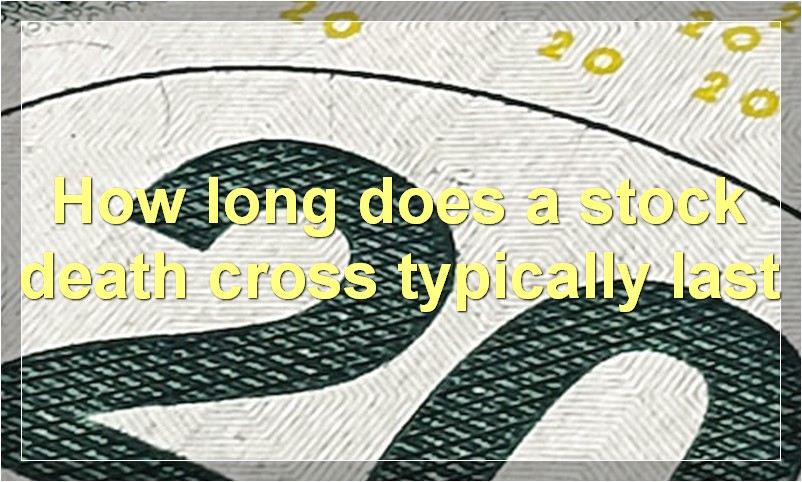The death cross is a technical indicator that is used by some traders to signal when a stock is likely to experience a downturn.
What is a stock death cross
A death cross is a technical indicator that is used by some traders to signal that a security is about to enter a bear market. The death cross occurs when the 50-day moving average (MA) crosses below the 200-day MA. This is seen as a bearish signal by some traders, who may then sell their holdings or short the security.
The death cross is just one of many technical indicators that traders use to try to predict future market movements. Some traders believe that the death cross is a reliable indicator of a forthcoming bear market, while others believe that it should be used in conjunction with other indicators. There is no perfect way to predict the future direction of the markets, and no indicator is 100% accurate. However, some traders find that the death cross can be a helpful tool in their arsenal.
What causes a stock death cross

A death cross happens when a stock’s 50-day moving average crosses below its 200-day moving average. This is generally seen as a bearish signal, as it indicates that the stock’s short-term momentum has shifted from up to down.
There are a few different things that can cause a death cross. One is simply a change in the overall market trend; if the market is in a long-term uptrend and then starts to head down, stocks will naturally start to experience more downward momentum.
Another possibility is that the company itself is experiencing some negative news or fundamentals. If a company misses earnings estimates or cuts its guidance, for example, this can send its stock tumbling lower. This can in turn drag down the 50-day moving average, eventually leading to a death cross.
Finally, it’s also worth noting that death crosses can sometimes be caused by simple technical factors. If there’s a lot of selling pressure around a particular moving average level, for instance, this can push the averages lower even if underlying fundamentals are unchanged.
So, while death crosses can be caused by a variety of factors, they’re generally seen as bearish signals that indicate that a stock’s near-term momentum has shifted from up to down.
How can investors identify a stock death cross
A death cross is a technical indicator that occurs when the 50-day moving average crosses below the 200-day moving average. This signals that a short-term downtrend has turned into a long-term downtrend, and is typically seen as a bearish sign.
There are a few ways that investors can identify a death cross. First, they can look at the chart of the stock in question and look for the 50-day moving average to cross below the 200-day moving average. Second, they can use a technical indicator called the MACD (moving average convergence divergence) which will show whether the 50-day moving average is above or below the 200-day moving average. Finally, investors can also look at the relative strength index (RSI) to see if it is below 50, which is another bearish sign.
If an investor sees any of these signs, it may be time to sell the stock or take other measures to protect their investment.
What implications does a stock death cross have for investors
A death cross is a technical analysis indicator that occurs when a stock’s 50-day moving average crosses below its 200-day moving average. This signals that the stock may be entering a long-term downtrend.
For investors, a death cross can be a bearish sign that it may be time to sell. However, it is important to keep in mind that this is only one technical indicator and should not be used alone to make investment decisions.
Is a stock death cross always a bearish indicator
A death cross is when the 50-day moving average crosses below the 200-day moving average and is generally considered to be a bearish indicator. However, it is important to note that a death cross can occur at the beginning of a new trend (bearish or bullish) and should not be used as the sole indicator for making trading decisions.
How long does a stock death cross typically last

When it comes to the stock market, a death cross is typically seen as a sign of bad things to come. This is because a death cross occurs when the 50-day moving average crosses below the 200-day moving average. This is generally seen as a bearish signal, as it indicates that the short-term trend is now bearish.
However, it’s important to keep in mind that a death cross is not necessarily a death sentence for the stock market. In fact, there have been instances where the stock market has actually rallied after a death cross. So, while a death cross may be a cause for concern, it’s not necessarily a reason to panic.
What happens to a stock after a death cross occurs
A death cross is a technical indicator that occurs when the 50-day moving average crosses below the 200-day moving average. This signals that the stock may be in a long-term downtrend. After a death cross occurs, the stock may continue to decline, or it may rebound and start to trend higher again.
Can a stock recover from a death cross
A death cross is when the 50-day moving average crosses below the 200-day moving average and is considered a bearish signal. However, this doesn’t mean that the stock will continue to go down. In fact, many stocks do recover from death crosses.
There are a few things to look for when trying to determine if a stock will recover from a death cross. First, look at the volume of the stock. If there is high volume when the death cross occurs, it is more likely that the stock will recover. This is because high volume indicates that there is interest in the stock and people are still buying it even though the price is going down.
Another thing to look at is the price action of the stock. If the stock has been in a downtrend for a long time, it is less likely to recover from a death cross. However, if the death cross occurs after a period of consolidation or even a small uptrend, there is a better chance that the stock will recover.
Ultimately, whether or not a stock recovers from a death cross depends on a number of factors. However, it is possible for a stock to recover and even go on to new highs after suffering a death cross.
Are there any stocks currently in a death cross
A death cross occurs when the 50-day moving average crosses below the 200-day moving average. This is considered a bearish signal and may indicate that the stock is about to enter a downtrend.
What are some recent examples of stocks that have experienced a death cross
In investing, a death cross occurs when the 50-day moving average crosses below the 200-day moving average. This signal is used by some traders to indicate that a stock is in a long-term downtrend and that it may be time to sell.
Some recent examples of stocks that have experienced a death cross are Apple (AAPL), IBM (IBM), and General Electric (GE). While this signal is not always accurate, it can be a helpful tool for traders who are trying to make decisions about when to buy or sell a stock.

